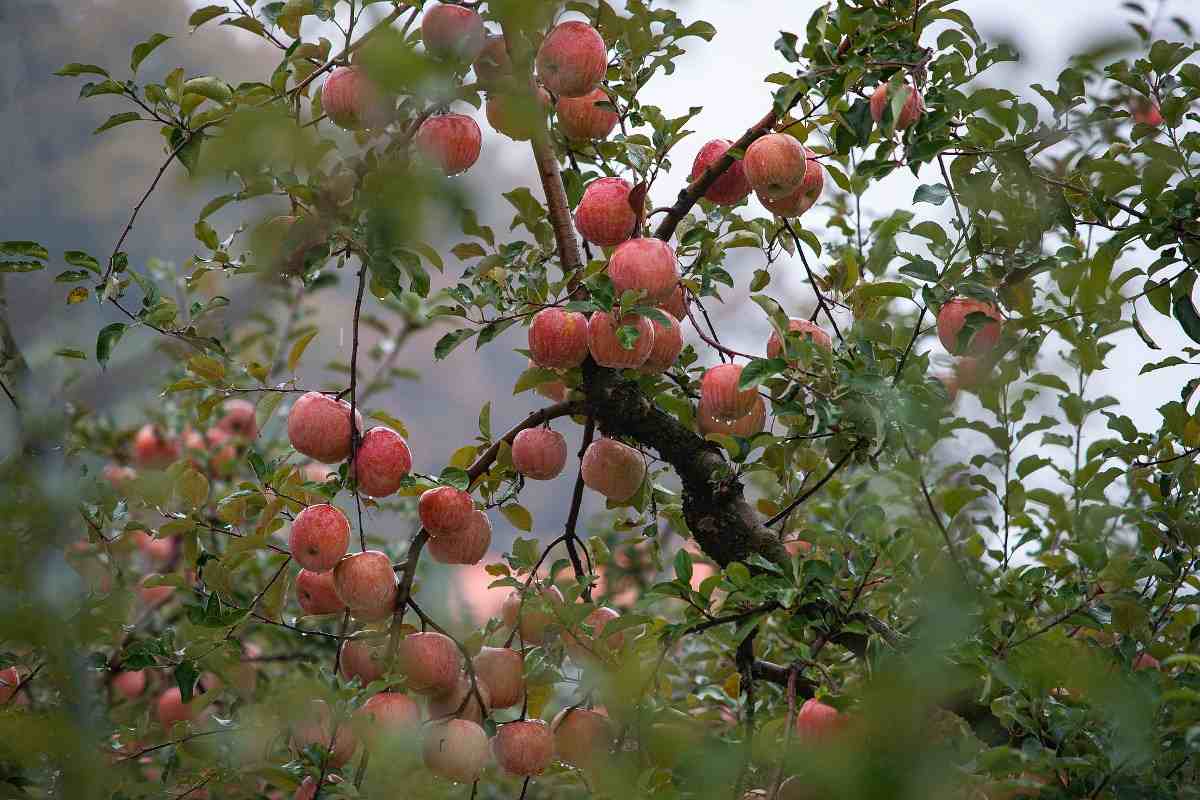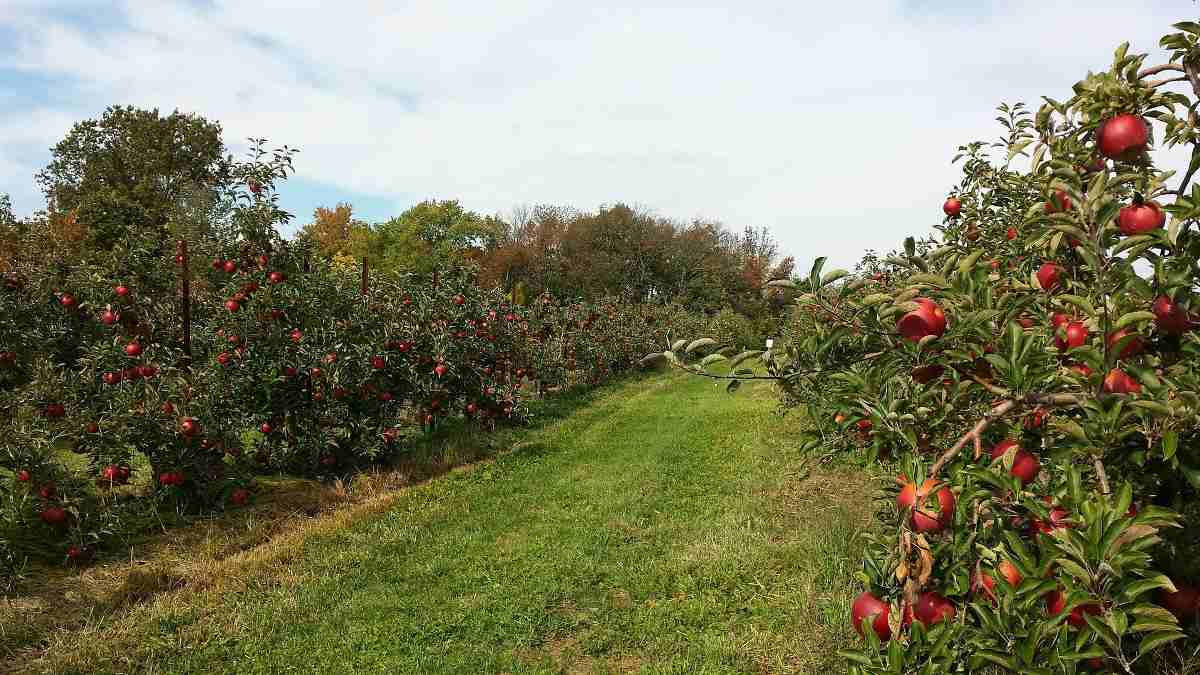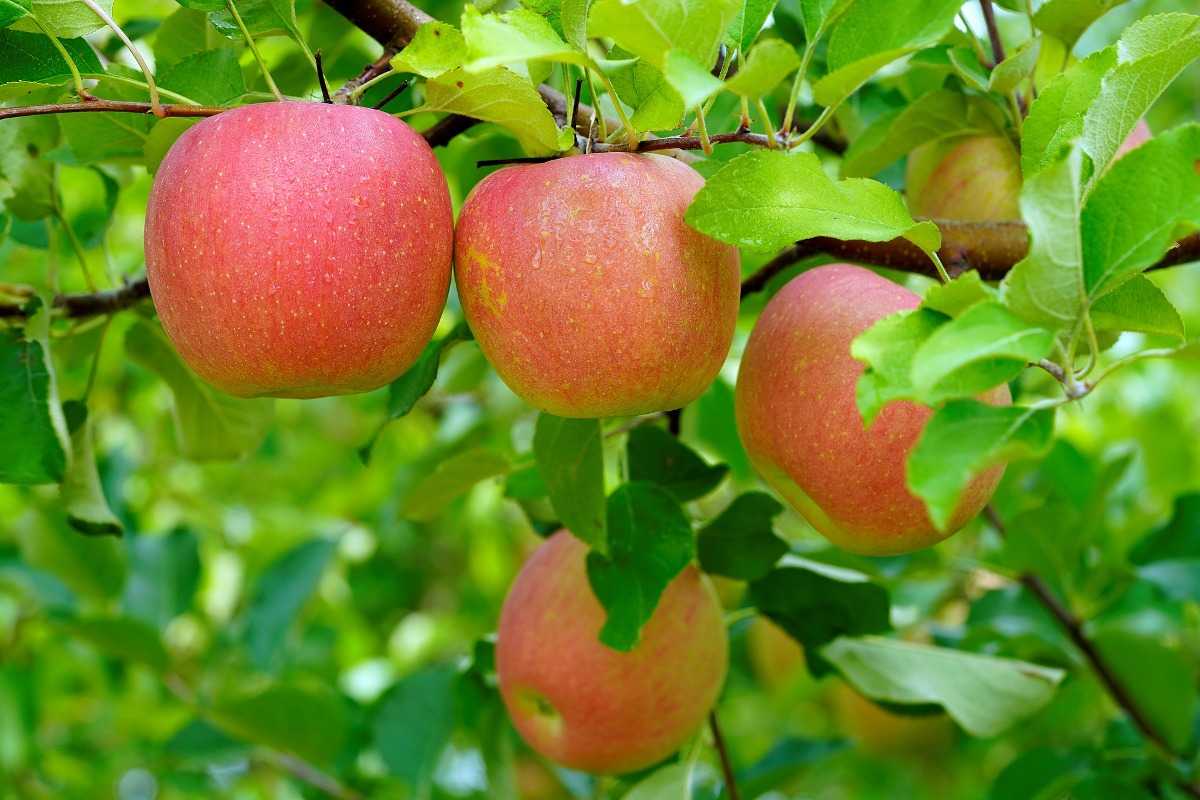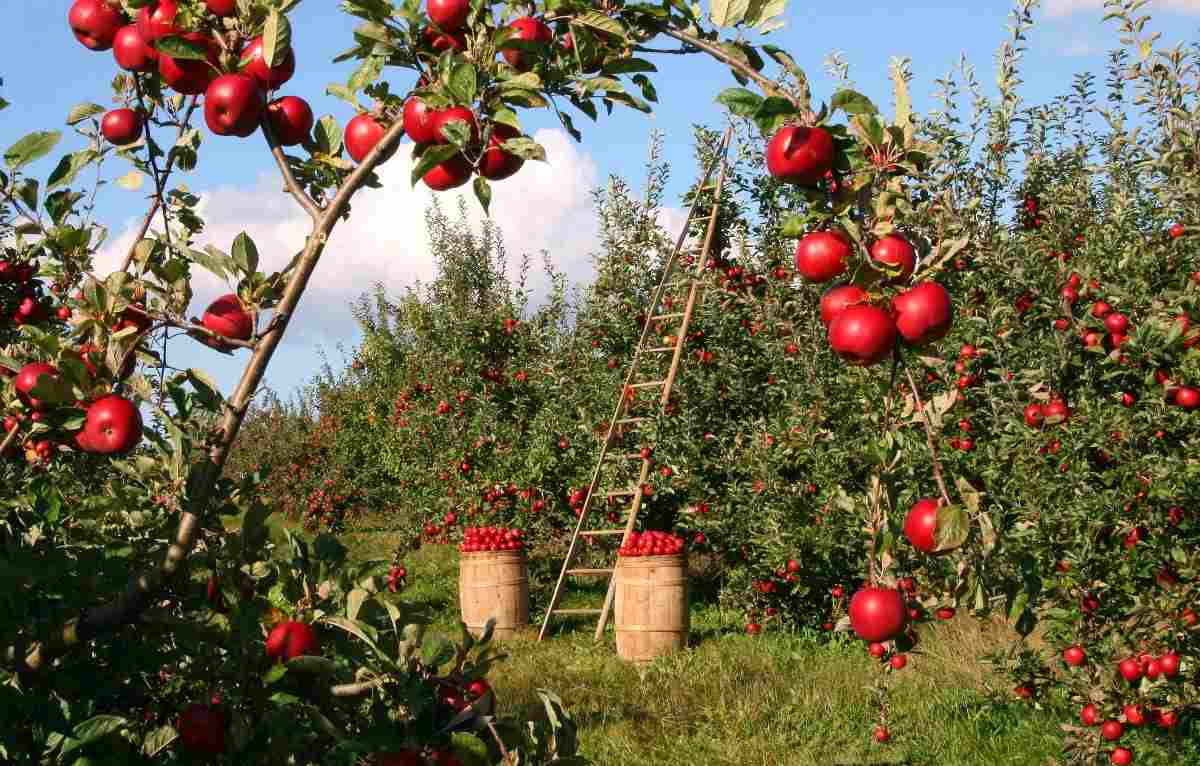Introduction to Organic Apple farming
An Apple is an edible fruit formed by an Apple tree. Apple is an important temperate fruit and mostly consumed fresh but a small part of the production is processed into juices, jellies, canned slices, and other items. The Apple is a hardy, deciduous woody perennial fruit tree that grows in all temperate zones. Apples grow best where there is cold in the winter season, moderate summer temperatures, and medium to high humidity. Many of the best management practices developed for conventional Apple production are likely to apply to organic systems. Organic Apple production involves more than simply excluding synthetic pesticides and fertilizers. Growing Apples organically is easy if you follow basic rules. Overall management strategies need to reflect the below key organic farming principles;
- Soil health largely determines plant health;
- Organic systems are biological systems;
- Organic farms must operate as closed systems as far as possible; and
- A holistic approach ensures good integration.
A step by step guide to Organic Apple farming practices
Organic agriculture is an integrated approach of active and observant management of farming. Organic Apples are sold for fresh consumption and therefore have to obtain high-quality requirements. The fruits should obtain the right size and be undamaged without important infections of pests and diseases. Apple scab causes brown or black color spots on the fruits and severe infections can result in fruits not suitable for consumption. This disease causes a big reduction in crop yield and quality in organic production.

Selecting trees for Organic Apple farming
Since Apple trees take at least several years to bear fruit, it pays to choose trees carefully before you invest time and energy in them. Consider these factors;
Apple trees come in a wide range of sizes to suit any yard, they make attractive landscape trees. Apples are subject to many serious diseases such as Apple scab. Then, choose resistant cultivars; new ones are being released every year.
An important consideration is the tree size. Standard trees can reach 30 feet and take 6 years to bear fruit. Most home gardeners prefer dwarf trees and semi-dwarf trees, which are grafted on a rootstock that keeps them small, grow 6-20 feet tall (depending on the rootstock used), and produce full-size Apples in just a few years. The final height of trees will also depend on what cultivar you select because some cultivars are more compact than others. Tree size will depend on growing conditions and pruning and training techniques. Some cultivars bear fruit on short twigs called spurs, while others make fruit along branches. Spur-bearing cultivars have more fruiting twigs than non-spur trees do, and make more Apples. Cultivars that have a strong, horizontal branching habit are very easy for beginners to prune.
Sample the fruit before you choose and find some less familiar cultivars at farmer’s markets and orchards, or order a collection from a mail-taste order sampler company. The range of aroma, taste, flesh texture, shape, color, and size of an Apple is far greater than a trip to the local supermarket would even begin to suggest.
Soil requirement for Organic Apple farming
Apple trees can be cultivated in all types of soil. Though, a loamy soil, rich in all essential organic matter along with well-drainage power is considered as the best soil for Apple farming. Also, it should have a pH level, ranging between 5.5 to 6.8 with proper aeration.

It is a good thing to go for at least one soil test to find out the suitability and soil fertility for Apple cultivation. It will help you in determining any deficiency of micronutrients in your soil if present. So, you can supplement them at the time of land preparation for obtaining higher fruit production.
Organic nutrients and fertilizers for Apple trees
The perennial nature of Apple trees requires their nutrient needs to be maintained in a holistic and long-term manner. Apple trees have special nutrient requirements that take into account both the need for good crop yield and fruit quality. Fertilizing to promote lush shoot growth and large Apple fruit size will be detrimental to the flavor, color, and shelf-life of Apple. On the other side, insufficient fertility can lead to small Apples and unproductive trees.
There are several essential nutrients, each with important functions in Apple plant growth. Some are used in large quantities, the macronutrients, and others in small quantities, the micronutrients (also known as trace elements). The goal of fertilizing is to keep the level of each nutrient within an optimum range. An excess of any nutrient leads to negative effects on the Apple tree that are difficult to correct. Deficiencies are more common and can be fixed by applying proper fertilizer.
Many commercial products are available for fertilizing, so check with the certifying agency to find out which ones are approved for use in organic orchards. Some products are not appropriate for foliar application to Apple fruit trees. Before buying any product, and make sure it has been previously tested on Apple to determine if it is safe or won’t burn fruit and foliage.
Groundcover and weed management for Organic Apple farming
Managing orchard understory vegetation is very important for weed suppression, attracting and sustaining beneficial arthropods that prey upon foliar and fruit pests, and protecting the soil surface beneath trees from erosion, weathering, and organic matter loss. Though, planted groundcovers and weeds in the tree row can also compete excessively with trees for water or nutrients, and give habitat for voles and other rodents. Weed management is cited as one of the main challenges in organic production.
Weed problems may be controlled through;
- Mulching with fully biodegradable materials
- Mowing
- Livestock grazing
- Hand weeding and mechanical cultivation
- Flame, heat, or electrical means; or
- Plastic or other synthetic mulches provided they are removed from the field at the end of the growing or harvest season.
When weeds are allowed to grow in the Apple tree row they can stunt tree growth, especially during orchard establishment, as well as reduce yields and fruit size. The optimal area for weed management around Apple trees is determined by soil type, tree age, and irrigation availability. In dwarf and semi-dwarf plantings, weeds must be controlled from the tree trunks out to 2 to 4 feet in all directions. Smaller weed-free areas can be sufficient in orchards with irrigation or very fertile soils. In most critical months for weed competition with fruit trees are May, June, and July; during autumn and the winter month’s tree requirements for soil nutrients are reduced. Therefore, groundcovers and weeds during 9 months of the year have minimal competitive effects on fruit trees and can provide beneficial protection for soil quality.
Organic products for fertilizing Apple trees
Healthy Apples grow 8-12 inches per year. Apples thrive with a yearly mulch of 2 inches of compost. Apples benefit from foliar feeding. If testing shows calcium is low, spray 4 more times at 2-week intervals.
When you shop for fertilizer you don’t want a product that is 100% nitrogen. Instead, you’ll choose a natural, organic fertilizer that is nitrogen-rich but contains other nutrients and products sold as fertilizers have an N-P-K rating expressed in numbers. If a product has a rating of 9-3-0, as a fish meal does, it means it has 9% nitrogen, 3% phosphorus, and no potassium. Nitrogen promotes green, leafy growth and phosphorus promotes root development and flowering. Potassium helps with fruiting and seed development.
When to apply an organic fertilizer to Apple trees
Adding fertilizer to Apple trees must be done 3 times during the growing season.
- Make the first application in early spring, before flowering, around mid-April month in most areas temperate areas.
- Make the second application about a month later, and after flowering is completed around the end of May.
- And the final application of fertilizer must be applied at the end of June, about a month after the second application.
Controlling the pests and diseases of Apples organically
In case if you miss this: Flour Mill Project Report, Subsidy, Cost, Loan, Permission.

Insects and diseases are a major frustration for organic Apple growers, but new resistant cultivars and pheromone-bated insect traps make it easier to cultivate Apples organically.
Best organic options for controlling apple tree diseases
You have a few ways to beat back difficult diseases that take over Apple trees. Two main organic farming techniques are;
Sprays – Serious diseases such as fire blight and apple scab that can take down healthy Apple trees quickly contain dormant oil sprays, such as a liquid copper soap or Bordeaux mixture. Many of these sprays can take out diseases that creep along unnoticed until it is too late. They won’t hurt the Apple tree when done correctly at the right time within the growing season.
Solar – Before planting a single tree or a crop of young trees, allow the sun to bake the soil and kill off lethal or soil-borne pathogens. Then, cover the soil with sheets of plastic and allow the sun to bake the ground for 2 to 4 weeks before you plan to plant.
Organic treatment for apple tree diseases
Apple Coddling Moth
The Apple coddling moth infests Apple trees. The larvae cause damage by boring a short distance into the flesh or to the core. Although it’s the most potentially damaging of all pests, you can effectively control mild infestations using organic methods. Some organic control methods contain cultural control, along with spraying products that have paraffinic oil, kaolin clay, or spinosad; apply these according to the product labels. For cultural control, pick up and get rid of dropped Apple fruit, and remove all infested Apples by hand before the larvae emerge as adults.
Apple Maggot
You can try to manage Apple maggots in trees organically by hanging one or two red, spherical, sticky traps impregnated with an attractant formulated for Apple maggots. Other organic methods to control Apple maggots in home orchards contain diatomaceous earth, pyrethrum products, and rotenone. As always, apply these based on the product labels.
Winter Moth Caterpillar
Winter moth caterpillars eat holes in the plant leaves; blossom and developing fruit lets of many tree fruits, ornamental trees, and shrubs. Severe attacks can weaken plants and extensive damage to fruit trees can affect crop yields and quality. Early damage on Apple fruit lets causes a deep cleft in the side of the fruits to develop by the time and they have reached full size in late summer.
Spinosad is available for Organic control of Winter Moth caterpillar, but the Soil Association wants to know what it is being used for as they are concerned that it must not be ‘overused’ Spinosad is a natural insecticide and the active ingredients in spinosad, spinosyn A and spinosyn D, are complex organic compounds made by specific an actinomycete.
Spinosad is a broad-spectrum, organic insecticide and the term “broad-spectrum” means that it is toxic to a wide variety of insects. It is, though, relatively non-toxic to mammals and beneficial insects. If used carefully only insects that eat something that has been treated, such as a leaf, are affected. Then, this is different than a lot of other broad-spectrum insecticides that are toxic if the insect merely comes in contact with dry insecticide residues.
Bacillus thuringiensis is commonly known as Bt, is an effective, natural, and safe microbial pesticide specifically targeting caterpillar pests. Bt sprayed during blossom combats Winter Moth Caterpillars.
Treating fungal diseases in Apple trees organically
In general, if you have found one of the common fungal diseases on the leaves and fruits of the Apple trees, there are a few steps and organic fungicides that can control the problem.
- Destroy fallen leaves and rake under the Apple tree regularly to reduce the fungal spores’ ability to spread in the air or into the soil.
- Water in the early morning or evening hours so leaves don’t stay wet long.
- Spread a layer of compost about 3 to 6 inches under the tree but not close to the trunk to tamp down the fungi’s ability to spread.
- Use an organic fungicide such as liquid copper soap 2 weeks before the growing season and then follow up with another treatment a week later as a preventative measure.
- If it’s a serious problem, apply an earth-friendly systemic fungicide to the soil to prevent the fungus from growing as well as to stop fungal issues from beginning in trees.
- Disinfect the pruning shears that you use with a solution of about 10 percent bleach and water or alcohol and water as you move across the Apple tree to ensure you don’t inadvertently spread the fungus.
Organic Apple harvesting
Choosing the optimal harvesting time prevents losses and influences fruit quality. Optimal harvesting time depends on the Apple variety and weather conditions during the growing season. It also depends on the purpose of Apple production. Harvesting at optimal maturity will help to preserve fruit quality, improve crop yields, and extend fruit storage life. Machinery harvest is more suitable for Apples for processing when the quantity of harvested fruits is important than the quality. When it comes to Apples for fresh consumption, manual picking is suitable.
Commonly asked questions about organic Apple farming
You may also check this: Drip Irrigation for Vegetables.

What is an organic Apple?
Now the delicious Apples that everyone has grown up loving are obtainable in organic. These Apples are grown without the use of harmful pesticides, fertilizers, and preservatives. Apples kept out of refrigeration to tend to become mealy and organic produce should not be stacked with non-organic produce.
What’s the difference between organic Apples and regular Apples?
Conventional Apples were found to harbor potential foodborne pathogens, making them less healthy for the consumer, host plant, and environment than organically grown Apples. Organic Apples were host to a significantly greater variety of “good” bacteria such as Lactobacillus, a probiotic with human health advantages. Organic Apples taste better and there is an unbelievable taste difference between organic Apples and conventionally-raised Apples. This is heavily due to how and when the Apple fruit is harvested during their lifecycle.
Are organic Apples organic?
This is mainly because organic pesticides are naturally derived, so they’re often not as effective. Some of the fungicides used in organic farming and conventional Apple orchards are the same, but scientists change an inert ingredient so one can carry the organic stamp of approval.
How long do organic Apples last?
Whole Apples usually last about a week, maybe up to 2 weeks, in the pantry before their skin starts to wrinkle and they turn mushy. If you store them in the fridge, and they keep for 4 to 6 weeks, sometimes up to 2 months before the quality starts to degrade.
How do you get rid of Apple scabs organically?
Spray the Apple tree foliage with a fertilizer mixture that contains about 5 percent urea just before leaf fall or apply the urea to fallen leaves as soon as possible after they fall if you will not be able to rake up and destroy and dispose of the leaves.
In case if you are interested in this: Growing Hydroponic Blueberries.
Please try and send this your article to my email address i really love it, I will be so happy if you can send it to me.
THE ARTICLE HAS COVERED ALL THE SIDES OF ORGANIC APPLE CULTIVATION. VERY GOOD.